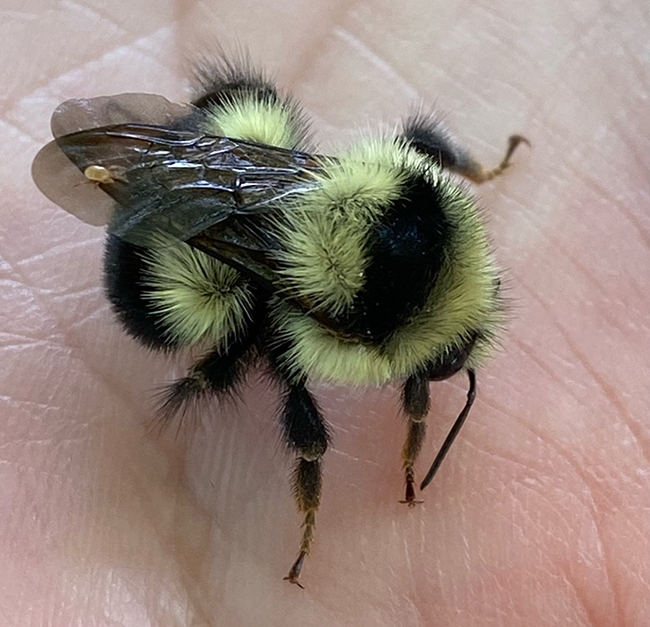
The Atlas, a community-science collaboration launched in March 2022 by the California Department of Fish and Wildlife (CDFW) and the Xerces Society for Invertebrate Conservation, seeks to track and learn more about California's native bumble bees. The Atlas is training citizen scientists to collect data to help conserve declining species.
"It was a small event but lots of fun," said tour leader Dylan Winkler, bumble bee scientific aide for the CDFW's Wildlife Diversity Program. He works closely with senior environmental scientist and pollinator coordinator Hillary Sardiñas of CDFW's Wildlife Diversity Program. She formerly worked for Xerces.
Winkler conducted the 10 a.m. field day on Saturday, May 28 and invited the public to participate.
"The event was really fun!" said participant and community ecologist Danielle Rutkowski, a doctoral candidate who studies with Rachel Vannette, associate professor, UC Davis Department of Entomology and Nematology. "We were able to catch three different bumble bee species, the yellow-faced bumble bee (Bombus vosnesenskii), the black-tailed bumble bee (Bombus melanopygus) and a few individuals of Bombus fervidus (commonly known as the golden northern bumble bee)."
"We spent some time going over survey methods and capture technique, and then caught some individuals and practiced taking photographs before releasing them," Rutkowski said. "It was a really great opportunity to see the abundance and diversity of bumble bees even in one small area of campus, and I'm really excited to get involved in some surveys in the Sierra, where diversity can be much higher!"
Rutkowski completed her bachelor's degree at Cornell University, where she studied how the relationship between mycorrhizal fungi and their host plants impacts insect herbivores. She currently studies “how bumble bees interact with the microbes, particularly fungi, in their environment, and how these relationships impact bee health.”
Winkler said the group netted a total of 15-20 bumble bees, representing the three species. "We also saw a few more. They were mostly on different salvia species, California poppies, and a native Solanum, the bluewitch nightshade. Surprisingly, there were also a couple on lavender and ceanothus."
Cindy McReynolds, an administrator and research scientist in the laboratory of UC Davis distinguished professor Bruce Hammock of the Department of Entomology and Nematology and Comprehensive Cancer Center, and who directs research at the Hammock-founded EicOsis, participated with her son, Elliot McReynolds, 13.
"We both are looking forward to working on the Atlas project," said McReynolds, who holds a doctorate in pharmacology/toxicology. "He is already hedging trips to the coast and mountains to look for bees."
Bumble Bee Alert. Back in September 2021, the U. S. Fish and Wildlife Service announced that the American bumble bee, "whose populations have plummeted by nearly 90 percent, may warrant Endangered Species Act protection." The announcement kicked off a one-year status assessment of the species. (See news story)
The California Bumble Bee Atlas is planning more field days to train citizen-scientists:
- Saturday, June 4: The Gardens at Lake Merritt, 666 Bellevue Avenue, Oakland, CA (Alameda County). Tour of the gardens from 9 a.m. to 11 a.m.
- Sunday, June 5: College of Marin at Kentfield (Marin County), parking at covered Lots 6/7 off College Ave, Kentfield, CA 94904. Details: Meet at bridge over Corte Madera Creek. Tour of the campus native plants from 10 a.m. to noon.
- Saturday, June 18: Soil Born Farms, Rancho Cordova, CA (Sacramento County), parking at Soil Born Farms: American River Ranch, 2140 Chase Drive, Rancho Cordova, CA 95670. As part of National Pollinator Week, the group will tour the gardens from 10 a.m. to noon. Closed-toed shoes required.
To register or to obtain more information, access https://arcg.is/0PDyO4.
Attached Images:
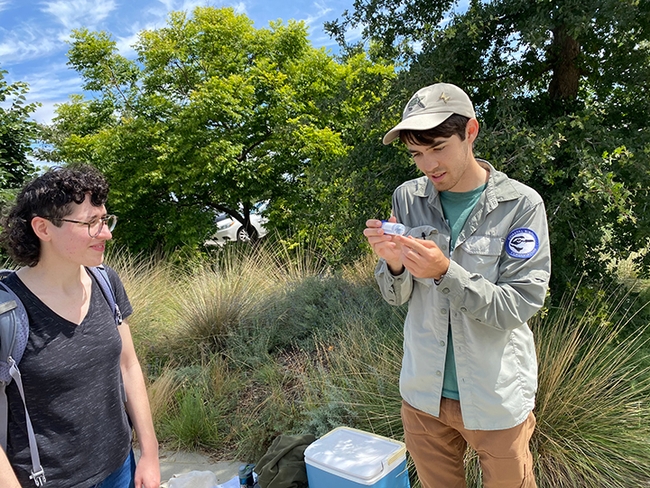
Tour leader Dylan Winkler, bumble bee scientific aide for the CDFWs Wildlife Diversity Program, checks out a bumble bee species. At left is UC Davis doctoral entomology candidate Daniele Rutkowski. (Photo by Cindy McReynolds)
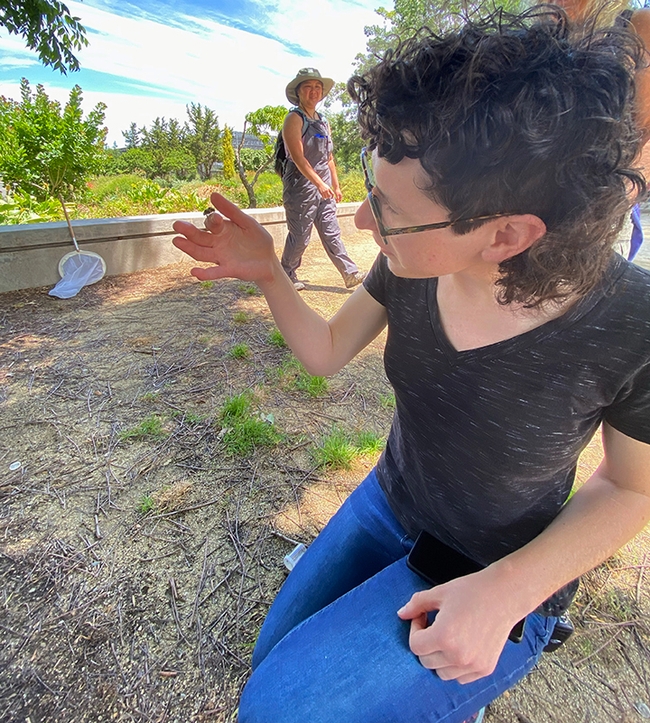
UC Davis entomology doctoral candidate Danielle Rutkowski examines a male black-tailed bumble bee, Bombus melanopygus. (Photo by Dylan Winkler)
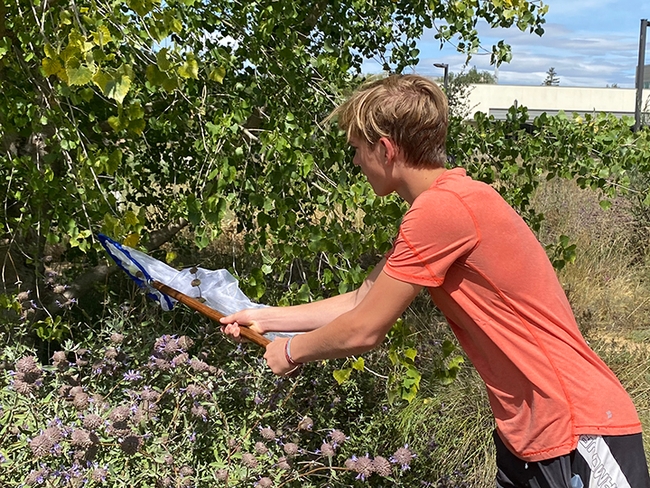
Elliot McReynolds, 13, of Davis, netting a bumble bee in the UC Davis Arboretum and Public Garden. (Photo by Cindy McReynolds)
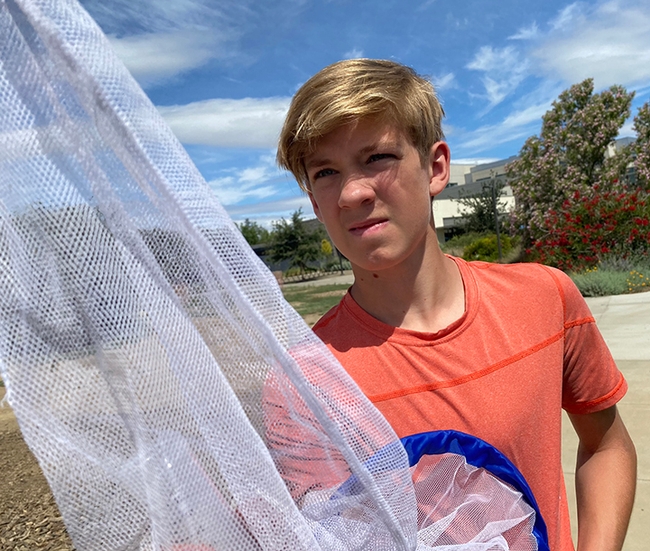
Atlas participant Elliot McReynolds of Davis, checks out his net. (Photo by Cindy McReynolds)